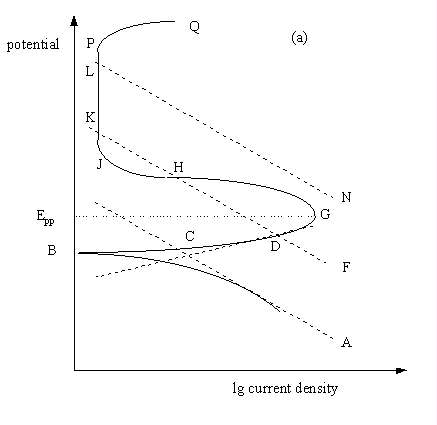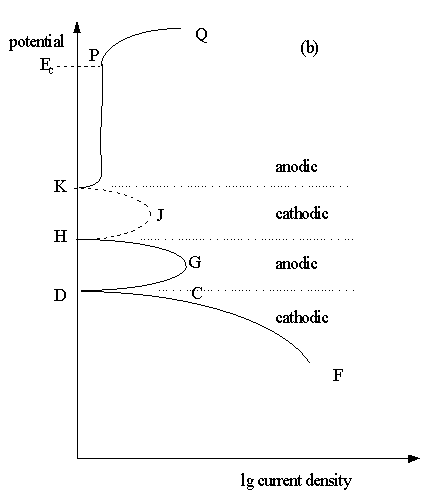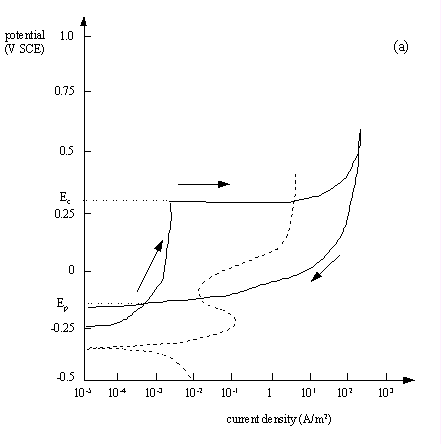|
|
[Previous Lecture] [Next Lecture] [Course Outline] [General Info] [Study Guide]
From previous lectures and tutorials we have observed that for some metals/alloys, when polarisation (anodic) increases, the current density and hence the corrosion rate of the metal/alloy increases; while for others, the corrosion rate will drastically decrease to a stable value and beome independent of the polarisation applied. This behavoir is referred to as passivating behavior and the metal/environment is referred to as a passivating system. Polarisation curves are particularly valuable in quantifying the behaviour of materials under various conditions. This section explains how elelctrochemical techniques are used to assess materials resistance to corrosion and what information can be obtained.

The schematic potentiodynamic polarisation behaviour of passivating
metals.
(a) General polarisation plot showing three possible theoretical cathode processes.
The solid line in Fig. 7.6(a) is a schematic E/lg i plot for a metal in a mild environment, such as an austenitic stainless steel in dilute sulphuric acid.
Some passivating metals have E/lg i plots which may show more than one corrosion potentials like in Fig.7.6(b). This indicates an unstable passivating system.

Fig.7.6(b) The schematic potentiodynamic polarisation behaviour of passivating metals.
These differences are caused by variation in the dominant cathodic process. Three possibilities are shown as dashed lines, CA, KF, and LN in Fig. 7.6(a). A different type of polarisation plot will be measured, depending upon which cathodic process predominates.

Fig.7.8(a) A cyclic polarisation (pitting 'hysteresis') curve for type 304 stainless steel in aerated seawater at 25 oC, scan rate: 0.1 mV s-1. The broken line shows a similar plot using aerated seawater + 4.5 M sodium chloride and HCl, adjusted to pH 1.2.
In general, the larger the area of the hysteresis loop, the greater the susceptibility to pitting corrosion.
Electrochemical techniques can be used to ASSESS materials resistance to
HOW ???
Potentiodynamic polarisation measurement: the E-lgi plot for information on
A corroding system can be classified as passive or non-passive system depending on the behaviour under anodic polarisation. Polarisation curves for the passive systems may show active/passive and/or passive/transpassive transitions. The current density in the passive state is generally very low compared with that in the active state. The stability of passivation depends on the predominant cathodic process (hydrogen evolution, reduction oxygen and reduction metal ions). Electrochemical techniques provide rapid, accurate and quantitative evaluation of a materials resistance to corrosion, particularly pitting. The critical pitting potential and the protection potential can be obtained from a cyclic pitting scan.
To reinforce learnings in this lecture read pages 172-177
(textbook)
To prepare yourself for the next lecture
read pages 191-197, 214-228 (textbook)